A History of the Parish Church of
St. Mary the Virgin, Nottingham
Mason's Marks and Graffiti
recorded by Brian Taylor
These were sighted by me while searching for the "votive
crosses" and are catalogued here for any who might be interested.
Nave pillars, or piers, are numbered east to west.
 My
search started with locating Holland Walker's "cross" on the
South Nave arcade pier S1. To my surprise, I found that there are three
such crosses close together on the same, west face, of that pier.
Examining other piers revealed a cross on the east face of pier N1. The
crosses are all the same size, are very clearly inscribed, possibly even
stamped on, and are of the form known in Christian symbolism as a "button
cross" (Liungman, 1991) or "cross pomeé".
The latter is a traditional emblem of St. Michael, the Archangel (Harl.
ms. 5285, British Museum, has this in red on a silver field). Later in my
background research, I came across the illustration by Harry Gill (1916,
right).
My
search started with locating Holland Walker's "cross" on the
South Nave arcade pier S1. To my surprise, I found that there are three
such crosses close together on the same, west face, of that pier.
Examining other piers revealed a cross on the east face of pier N1. The
crosses are all the same size, are very clearly inscribed, possibly even
stamped on, and are of the form known in Christian symbolism as a "button
cross" (Liungman, 1991) or "cross pomeé".
The latter is a traditional emblem of St. Michael, the Archangel (Harl.
ms. 5285, British Museum, has this in red on a silver field). Later in my
background research, I came across the illustration by Harry Gill (1916,
right).
Then, and quite unexpectedly as I was not searching, I came upon another
button cross on a section of the moulding above left of the east door from
the north transept to the "Chapter House". The moulding
itself is a section of a prominent band of concave sill moulding which
runs in an essentially unbroken line right around the inside of the walls
from the northeast tower pier to the southeast tower pier. Ironically,
this particular section survived being removed, cut down in size, and
replaced alongside a section of fresh stone (sill cum architrave) when a
pair of new doorways out of the north transept were made in 1940. So now
the evidence had swung towards the button cross being a mason's mark and
not some travellers or Crusaders votive cross.
Over a period of time, my list of button cross locations grew quite
remarkably. As the search progressed a range of other marks and graffiti
were alighted upon, often with a sighting owing much to the changing
natural light patterns in this great house of light as the seasons passed.
Of the button crosses more later but one fact seemed clear, they are all
on some of the smoothest quality stone in the whole building. A second
mason's mark, the "tristar" (my name for it) was located
on stone work which clearly shared the characteristics of that with button
crosses.
To return to the stonework bearing a button cross or a tristar, and
there is never more than one mark on an individual piece of masonry,
perhaps the most exciting find was that alongside King Richard's Head. On
the right of the ancient and original doorway in the north aisle, leading
into what most think was a Chantry House. The various locations of the
button cross and tristar, moreover tell us much about the period of
construction of the present building. In addition to those already
described, others are:- high on the shaft of nave pier N1; on the windows
in both transepts (mullions and frames); on another roll moulding section
in the north wall of the north transept; on the right door frame of the
North aisle tower entrance; and, on the large corner stone next to the
Smith monument in the south aisle. Those on window frames and mullions are
all on masonry which is embellished by a narrowly separated pair of
decorative lines. This double line is missing from most, if not all,
replacement mullions and frames. The finding, the last for me, of a
button cross on the window above left of the 1942 north aisle doorway
leading to the Choir vestry, denotes a continuity of building work which
embraces the two transepts and both aisles, including the nave pillars.
Figure 1 maps the horizontal position of the locations of the
button crosses and tristars.
Figure 1 - Click thumbnail photos for larger
illustrations

Simple Marks
Most were "captured" using the "brass-rubbing"
technique (some mainly initials being transformed to an "embossed"
form), the others are shown as drawings.
| Nave pillar S1, W. face, cross pomeé |
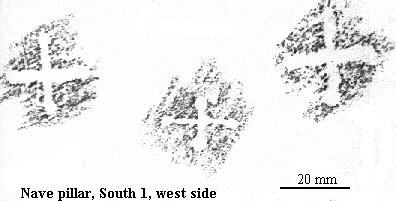
|
| Nave pillar N1, E. face, cross pomeé |
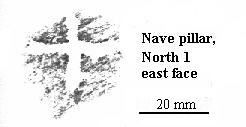
|
| Inside left of N. transept tomb, cross pomeé |
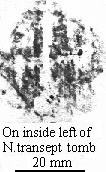
|
| N. transept/N.aisle junction, S. face, cross pomeé |
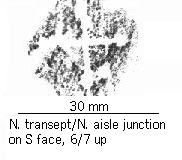
|
| N. transept, E. wall, "tristar" |
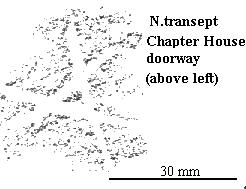
|
| N. aisle, r. of tower door, "tristar" |
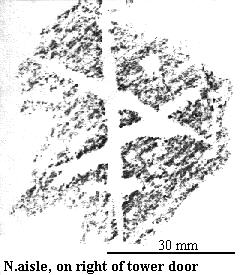
|
| Various locations, drawings |
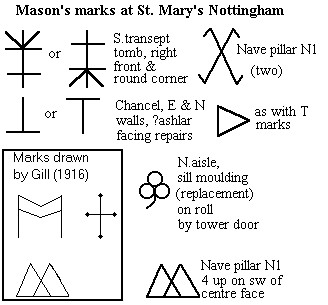
|
Initials found carved into stones

| Nave pillar S3, west face |
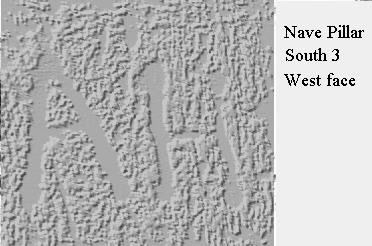
|
| Nave pillar S2, east face |
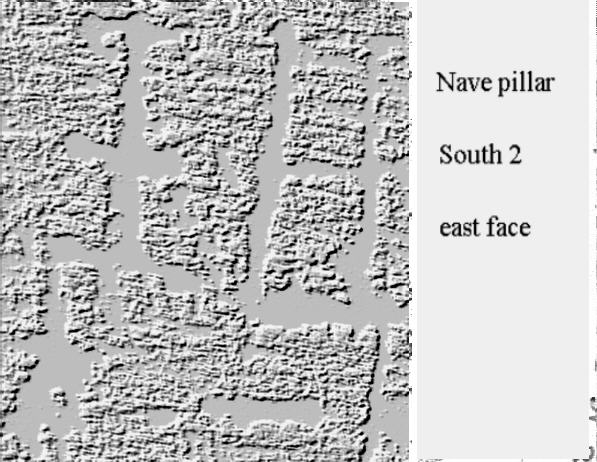
|
| Nave pillar N1, east face |

|
| Samon Tomb |
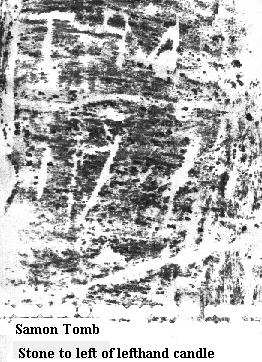
|
| Samon Tomb |
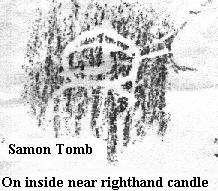
|
| Samon Tomb |

|
| Samon Tomb |
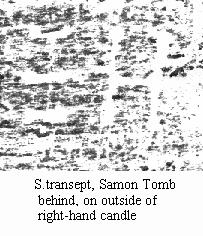
|
| North transept, west wall |
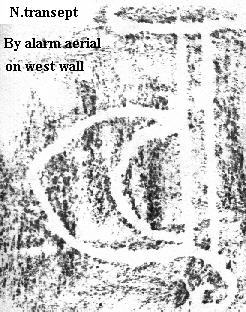
|
| N. transept/N. aisle junction, cross higher to
right |
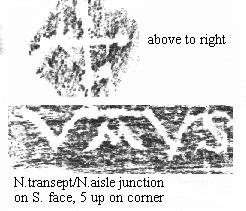
|
| Nave pillar N4, on S. face of arch |
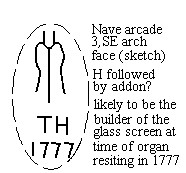
|
Text carvings
| Nave pillar N1, S.W. face |

|
| Nave pillar, S1, S.W. face |
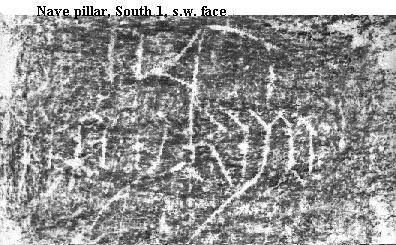
|
| North transept, by plaque to Henry Plumtree |
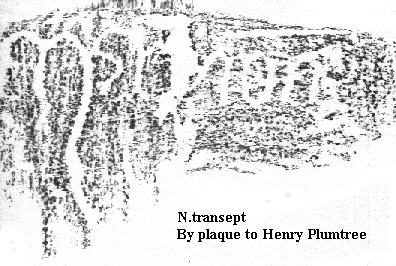
|
Mixed
| S. transept/S. aisle junction |
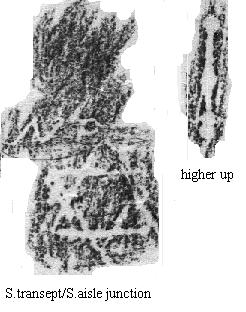
|
 Return to Home Page - use only if this page is open other than in a
frame
Return to Home Page - use only if this page is open other than in a
frame
Almost all the above material is original and, so, ©2000 -
Brian Taylor BTech PhD CBiol FIBiol FRES, 11, Grazingfield, Wilford,
Nottingham, NG11 7FN, U.K.
Compiled by Brian Taylor, published September 2000
Comments to dr.brian.taylor@ntlworld.com
stmarys/2ws&anxa.htm
 My
search started with locating Holland Walker's "cross" on the
South Nave arcade pier S1. To my surprise, I found that there are three
such crosses close together on the same, west face, of that pier.
Examining other piers revealed a cross on the east face of pier N1. The
crosses are all the same size, are very clearly inscribed, possibly even
stamped on, and are of the form known in Christian symbolism as a "button
cross" (Liungman, 1991) or "cross pomeé".
The latter is a traditional emblem of St. Michael, the Archangel (Harl.
ms. 5285, British Museum, has this in red on a silver field). Later in my
background research, I came across the illustration by Harry Gill (1916,
right).
My
search started with locating Holland Walker's "cross" on the
South Nave arcade pier S1. To my surprise, I found that there are three
such crosses close together on the same, west face, of that pier.
Examining other piers revealed a cross on the east face of pier N1. The
crosses are all the same size, are very clearly inscribed, possibly even
stamped on, and are of the form known in Christian symbolism as a "button
cross" (Liungman, 1991) or "cross pomeé".
The latter is a traditional emblem of St. Michael, the Archangel (Harl.
ms. 5285, British Museum, has this in red on a silver field). Later in my
background research, I came across the illustration by Harry Gill (1916,
right).




















